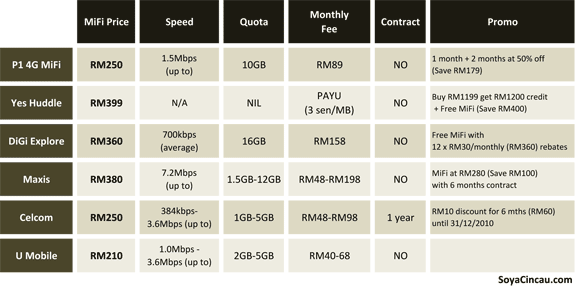Cost of Mobile Wireless in Penang for Expats
Before we even settled on our place, I began looking for a way for our family to have internet access during the 2 1/2 months we’d be living in Penang.
My wife was skeptical we’d use it. But the reality is, if you want to do even light surfing, you need internet access. It’s not realistic to expect to use the so-called “Wi-Fi” rooms the condos have. The quality of the bandwidth there is horrible.
Problem for us as temporary ex-pats, we weren’t going to be here long enough for get a fixed-line, which typically require 12 or even 24 month contracts.
The only no-contracts were pre-paid mobile services, or MIFI.
Shopping around for them was difficult. I found most of the service offerings confusing.
I went with what the online press said would be the best 4G service for Penang. Many of these telcos primarily service Kuala Lumpur, so I narrowed it down by looking for those with 4G in Penang.
Thanks to soyacincau’s blog I found a basic matrix of providers, but basically went with Yes based on the map they had showing coverage of Georgetown with 4G.
What were the costs?
I had to purchase the Huddle XS device for RM$399. Here are how the costs broke down from what I would say was less-than-average usage compared to what we did in the states. No streaming movies. No streaming music. Occasionally downloading and streaming podcasts (by accident). Mostly regular surfing and blogging. I did have some Skype calls. Originally I tried to limit these during the cheaper non-peak hours, but it wasn’t convenient.
July 14 - August 13 2014 - RM$441.40
This included the RM48 to get me on the lowest monthly plan (2GB).
The total was RM441.40. This mostly consisted of me getting “booster bandwidth” purchases. I hadn’t projected the bandwidth cost, so I ended up buying in the more expensive dribs and drabs, rather than just minimizing by cost-per-GB by going with the maximum 5GB.
So this comes out to about US$147.00 for the month in bandwidth.
By comparison, I think I pay US$60 for unlimited bandwidth plus unlimited nation-wide calling. Granted, that is DSL, but still.
August 14 - September 13 2014 - RM$270
The total for this month was RM$270. We were gone for like two+ weeks so that sort of makes sense. This ended up being US$90.
September 14 - ? 2014
We haven’t quite finished out the week, but I am hoping that we aren’t going to need to spend more than the RM$35 by the time we leave Saturday.
Total costs to have basic internet at our condo
This was definitely not one of the areas we saved money by being in Penang. This doesn’t even include the mobile phone costs, which I’d like to try to tally next. Our total for the trip looks like it will be around RM$750 just for data. Roughly US$260!
What about our cell phone usage?
Tracking our cell-phone usage, unfortunately, is even harder because we have to buy “reloads” with cash. I probably should have kept the receipts or the used Digi reload cards.
If I had to estimate, the total was probably around RM$200 – I know there was a point where both of our phones reloaded for RM$60 each, I also loaded for around RM$50 and then we had miscellaneous reloads in RM$10 increments along the way.
With cell-phones, this amount can be used both for calls and for data. It’s not that easy to ration. My wife kept asking me, “How come you don’t know how much you used for data?” and I had to explain that the way data is calculated is by paying for a “subscription plan” which can come in daily, weekly, or monthly increments with a fixed quota.
You actually can see the total amount of remaining bandwidth you are allowed, and could of course calculate the cost-per-GB if you had to based on the plan you selected.
The calls appeared to average around RM$.30 per quick 20-second call. And I believe there is a charge for SMS.
Summary on wireless and mobile costs in Penang
It ain’t cheap during the 2 1/2 months.
- Mobile Internet: around US$260
- Cell phone (data and call): around US$70 for two people
The cell phone costs doesn’t look that high. But the only people we were calling we taxi-drivers and those calls tended to be less than 20-seconds each. Calling vendors or being put on hold (as I was by Yes multiple times) could be costly. Downloading anything, including apps (such as the MyTeksi app which needed to be re-downloaded multiple times) definitely consumed bandwidth.
If I were to do anything differently, I would start with the maximum bandwidth plans for each to save on my per-GB cost.
For the mobile internet, we were defintely using more than 10GB each month, and this cost RM$158 on their subscription plan. Turns out, the booster was slightly more economical: It was RM$75 for 5GB (or RM$150 for 10GB). Since we weren’t going to be here for a full three months, it made sense to subscribe at the absolute lowest and just get boosters at the maximum. My hunch is that we probably still would have spent a similar amount.
This is one of those unavoidable trade-offs as far as I can tell: we didn’t want a contract, which left us with mobile data plans.
If you did want to look at other options and compare, here is the matrix from the original blog:
